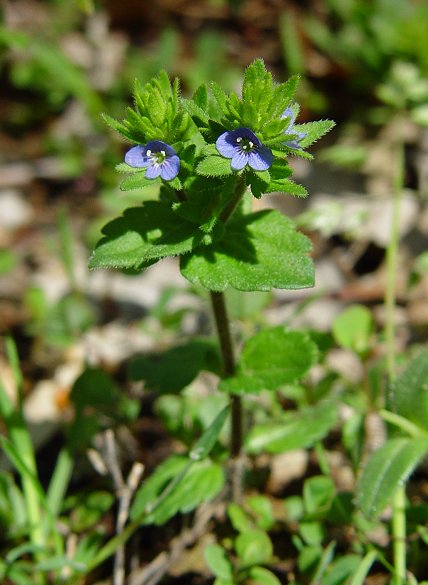Veronica arvensis L.
Corn Speedwell

Introduced
CC = *
CW = 3
MOC = 71
© DETenaglia
Veronica arvensis L.Corn Speedwell | |
 |
Introduced CC = * CW = 3 MOC = 71 |
© DETenaglia |
|
Family - Plantaginaceae Habit - Annual forb with slender taproot. Stems - Sprawling to erect, to 30 cm, or multiple from fibrous roots, sometimes rooting at lower nodes, moderately pubescent with longer, spreading, nonglandular hairs toward the base, grading into short, often glandular hairs toward the tip.
Leaves - Opposite, petiolate below, sessile above. Blades 0.5-1.8 cm long, 1-2 times as long as wide, ovate to nearly circular, broadest at or below the midpoint, rounded or bluntly to sharply (but broadly) pointed at the tip, broadly angled to rounded, truncate, or shallowly cordate at the base, those of the sessile leaves sometimes slightly clasping the stems, the margins unlobed, more or less flat, the veins impressed on the upper surface, finely to relatively coarsely scalloped or bluntly toothed, the upper surface glabrous or sparsely pubescent with more or less spreading, nonglandular hairs, the undersurface and margins usually more densely hairy.
Inflorescence - Terminal, elongate, moderately dense, spikelike racemes, with 6-15 flowers, the axis visible between the flowers (except at the start of flowering), the bracts alternate, 3-10 mm long, gradually reduced toward the axis tip, the lower ones similar to the adjacent foliage leaves, the upper bracts narrowly lanceolate to narrowly oblong-lanceolate. Flowers sessile or on stalks to 1 mm long, shorter than the calyces.
Flowers - Calyces 3-6 mm long, the lobes unequal, the upper 2 lobes noticeably shorter than the lower 2 lobes, deeply 4-lobed, the lobes linear to more commonly lanceolate, hairy, the hairs often glandular. Corollas 2-3 mm wide, 4-lobed, blue to bluish purple with darker veins, the throat white or greenish-tinged, the tube appearing relatively broad, wider than long, the lobes loosely ascending to broadly bell-shaped. Style 0.4-1.0 mm long at fruiting. Stamens 2, erect, adnate at the base of the corolla tube. Filaments whitish, glabrous, to 1 mm long. Anthers bluish and white. Ovary superior, green, orbicular, compressed, pubescent on the margins.
Fruits - Fruits 2.5-3.5 mm long, wider than long, heart-shaped in profile, flattened, the notch relatively deep (0.4-0.8 mm), the margins with spreading, glandular hairs. Seeds 8-12 per locule, 0.7-1.0 mm long, strongly flattened, the surfaces appearing smooth or nearly so (faintly and finely ridged and pitted), orangish brown to brown.
Flowering - April - August. Habitat - Forests, streambanks, prairies, savannas, glades, and tops of bluffs, fields, lawns, railroads, roadsides, and open, disturbed areas. Origin - Native to Europe. Lookalikes - Several other species of Veronica, particularly V. polita and V. hederifolia. Other info. - This little introduced species can be found throughout Missouri, as well as across most of the continental U.S. (uncommonly in the western Great Plains). The genus is easily identified by the small blue flowers and heart-shaped fruits, but identification to species requires attention to details. V. arvensis is characterized by relatively small flowers which are nearly sessile, and leaves which are scalloped but not deeply lobed. It flowers in the spring but usually not as early as V. polita. Photographs taken in Brown Summit, NC., 4-12-03 (DETenaglia); also near St. Albans, Franklin County, MO, 4-28-2015, Weldon Spring Conservation Area, St. Charles County, MO, 5-31-2020, and Shaw Nature Reserve, Franklin County, MO, 5-20-2022 (SRTurner). |